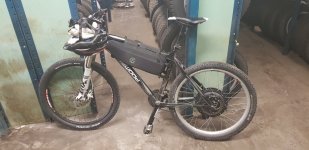Isak.svensson
1 mW
- Joined
- Jul 19, 2017
- Messages
- 11
Hi!
I'm allready feeling that my 48v battery is not going to last that long for me, i have an obsession with going faster and faster.
Currently looking into upgrading to 72v battery and controller.
(my rear DD hub will take 72v with no problem)
You guys that have swapped from 48 to 72, how much more top end speed and acceleration did you guys get?
Is it worth it?
I live on the country side with long straight roads that my current top speed of 50km/h with (80-90% battery) isnt enough ;/
best regards
I'm allready feeling that my 48v battery is not going to last that long for me, i have an obsession with going faster and faster.
Currently looking into upgrading to 72v battery and controller.
(my rear DD hub will take 72v with no problem)
You guys that have swapped from 48 to 72, how much more top end speed and acceleration did you guys get?
Is it worth it?
I live on the country side with long straight roads that my current top speed of 50km/h with (80-90% battery) isnt enough ;/
best regards


